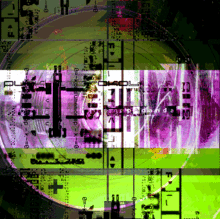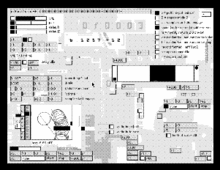Netochka Nezvanova (author)

Netochka Nezvanova is the pseudonym used by the author(s) of nato.0+55+3d, a real-time, modular, video and multi-media processing environment. Alternate aliases include "=cw4t7abs", "punktprotokol", "0f0003", "maschinenkunst" (preferably spelled "m2zk!n3nkunzt"), "integer", and "antiorp". The name itself is adopted from the main character of Fyodor Dostoyevsky's first novel Netochka Nezvanova (1849) and translates appropriately as "nameless nobody." [1]
Besides her audio-visual software art, the fame and notoriety of 'Netochka Nezvanova' stems from the complex and intricate online behavior she displayed through her various identities on countless mailing lists and websites, by which she mesmerized and vexed some internet users and the operators of her software products alike.
History
The earliest identity "=cw4t7abs" (antiorp@tezcat.com) surfaced in 1995 on mailing lists and newsgroups relating to electronic music production (for instance, the Kurzweil K2000 music synthesizer) and related Usenet groups (rec.music.makers.synth), rendering them speechless with spiralling messages saturated in a dense fogginess of code-poetry, abstract ASCII art as well as exceptionally focused personal engagement.
Disregarded by some for openly neglecting western morals and netiquette, her personas (at that time mostly "integer") gained admiration among the Internet art scene, particularly after the release of the video processing software nato.0+55+3d that became a respected tool in the emerging genres of real time video, laptop performance, VJs and live-electronic music.[2] From the original and clever online licensing mechanism (which has since become an industry standard) and the exquisitely beautiful demonstration programs and help ("humanitarian assistance") patches, Netochka's predictably Balkan world view,[3] subjected those who chanced upon her work, to consciously experience the full meaning of what she termed "love theory" or empathetic programming.
Besides the numerous software projects, her CD entitled "KROP3ROM||A9FF" was released by Decibel Records in 1997. It was described by Keyboard magazine as something 'unlike anything heard before'. It brings together a cornucopia of influences from electroacoustic art music as well as the industrial and cinematic genres. A second CD entitled sin(x) was released by 0f0003 in 2000.
Identity
A contribution to the enigma of Netochka Nezvanova and her various alter egos is the mystery around the persons behind them. For several years, rumors circulated that ranged from artists claiming to have in fact seen her passport to allegations that certain well-known celebrities were behind the fictitious persona. On February 26, 1998, New Zealand artist Rebekah Wilson performed an extract of A9FF at the "Electric Insights" concert at Victoria University of Wellington; this established the rumor that the originator or primary creative force behind Netochka is Rebekah Wilson. In the early 2000s however, Netochka's persona made several appearances at international media art festivals with different performers taking her place.
The author Florian Cramer incorrectly claimed that "It is known today that NN was a collective international project, with the person who wrote NATO differing from the one who wrote the message [by Netochka Nezvanova] quoted above."[3]
Even though the personal identities behind the pseudonym as well as their artistic intentions and strategies remain under dispute even today, Nezvanova's experimental web browser "nebula.m81" co-won the 2001 artistic software award with Adrian Ward at Transmediale in Berlin, and she was awarded the fictitious post "Director of Leaves and Petals" at the Dutch live electronic music centre STEIM in Amsterdam, where Nezvanova worked as a curator from 2002.
Since 2006, Gheorghe Dan, "director of 0f0003 Maschinenkunst",[4] has held several international conferences, illuminating the typically confused western audiences about Netochka Nezvanova.[5]
Other software created by NN

- 0f0003 propaganda (1998) - this program algorithmically generates animated graphics and synthetic sounds.
- b1257+12 (1998) - a software for sound deconstruction and composition. The intricate operator interface allows for radical manipulation of soundloops in realtime, offering a large amount of control parameters which, every now and then, take a life of their own. The name of the software refers to a rapidly rotating neutron star.
- @¶31®�≠ Ÿ (1998) - this software extracts random samples from a CD and creates a stochastical remix, accompanied by futuristic-looking graphics (according to the reference documents, it is intended for use with the krop3rom||a9ff release).
- m9ndfukc.0+99 and k!berzveta.0+2 (1999) - two programs written in Java interpreting network data, very likely preliminary versions of nebula.m81.
- kinematek.0+2 (1999) - another Java application that performs "animated image generation from internet www data", incorporating parts of nebula.m81.
- nebula.m81 (1999) - an experimental web browser written in Java, rendering HTML code into abstract sounds and graphics. Awarded at the International Music Software Competition in Bourges 1999 and at Transmediale 2001 (first prize in the category "Artistic Software"). Described by jury member Florian Cramer as "an experimental web browser that turned browsing into something resembling measurement data evaluation".[6]
- !=z2c!ja.0+38 (1999) - an application that generates a dense visual texture based on the user's keyboard input. It (ab)uses Mac OS' QuickDraw capability and can therefore be seen as a preliminary step towards nato.0+55.
Musical Works
- "krop3ropm||a9ff", audio CD, Decibel Records, 1997 (re-released by 0f0003 in 1998, with additional material by The Hafler Trio).[7]
- "A9FF" (1997), a piece for tape by Rebekah Wilson, performed at Victoria University of Wellington in February 1998.[8]
- "8'|sin.x(2^n)", hybrid CD containing audio and mp2 data tracks (1999, self-produced).[9]
- Trilogy of theatre pieces in collaboration with vocalist Ayelet Harpaz, based on haikus by the Japanese poet Masaoka Shiki ("Two Autumns", "I Keep Asking How Deep The Snow's Gotten"; "Spring: Still Unfurled"; presented in Utrecht, Amsterdam and Moscow, 2001–2002).[10]
- "Poztgenom!knuklearporekomplekz", included on the CD Strewth! An Abstract Electronic Compilation, published in 2002 by the Australian record label Synaesthesia.[11]
- "La lumière, la lumière .. c'est la seule .." (2002), for viola, piano, percussion and electronics. Commissioned by Ensemble Intégrales, performed in Ireland, Belgium, Switzerland, Austria and Germany (2003–2005).[12]
- "A History of Mapmaking" or "Aerial Photography and 31 Variations on a Cartographer's Theme", for amplified cello and light controller, composed and performed by Rebekah Wilson. Performances in Auckland (Transacoustic Festival 2005),[13] Ljubljana (City of Women 2006 Festival),[14] Berlin (Transmediale 2007),[15] Linz (Ars Electronica 2007).
Notes
- ↑ Fyodor Dostoyevsky (1849): Netochka Nezvanova. Translated with an introduction by Jane Kentish. Penguin Books. 1985. ISBN 0-14-044455-6
- ↑ "Her «Nato» software is currently one of the most popular tools used by all VJs for live visuals, as it can attach any visual object directly to a sound and thus create a flow of images that are linked to the music but can be mixed and edited as wished." - Daniels, Dieter (2004). "Sound & Vision in Avantgarde & Mainstream". Retrieved 2008-01-08.
- 1 2 Cramer, Florian. (2005) "Software dystopia: Netochka Nezvanova - Code as cult" in Words Made Flesh: Code, Culture, Imagination, Chapter 4, Automatisms and Their Constraints. Rotterdam: Piet Zwart Institute. Retrieved on: 2007-07-14
- ↑ Gheorghe, Dan; Andrasek, Alisa (2006). "Reality is too komplex 4 oraL kommunikation". neoscenes. Retrieved 2009-08-25.
- ↑ Gheorghe, Dan (2006). "Living in Limnos, Betwixt and Between: A Trans-Reality Balkan Odyssey (Symposium abstract)". Subtle Technologies. Retrieved 2009-08-25.
- ↑ "|\|05+/-\|_G!/-\.m2cht.fre!!! |>!G35+ [weiss, taiuti, cramer]". <nettime. 2004-08-25. Retrieved 2014-06-02.
- ↑ R.A. Falesch: It's All in How You Hex It, Retrieved on: 2008-01-15
- ↑ "Retrieved on: 2008-01-15". Retrieved 2014-06-02.
- ↑ "Retrieved on: 2008-01-15". Nettime.org. Retrieved 2014-06-02.
- ↑ "Retrieved on: 2008-01-15". Circadian.net. Retrieved 2014-06-02.
- ↑ "Retrieved on: 2008-01-15". Dustedmagazine.com. 2002-10-17. Retrieved 2014-06-02.
- ↑ Retrieved on: 2008-01-15 Archived August 5, 2007, at the Wayback Machine.
- ↑ Retrieved on: 2008-01-15 Archived October 16, 2008, at the Wayback Machine.
- ↑ Retrieved on: 2008-01-15 Archived November 3, 2007, at the Wayback Machine.
- ↑ Retrieved on: 2010-11-21
References
- Albert, Saul (May 2002). "Useless Utilities". Retrieved 2007-08-24.
- Arns, Inke (2004). "Read_me, run_me, execute_me. Code as Executable Text: Software Art and its Focus on Program Code as Performative Text". Medien Kunst Netz. Retrieved 2007-08-24.
- Carroll, Thomas (2002-05-21). "Nameless Nobodies as Virtual Intelligence". Nettime-l. Retrieved 2007-08-24.
- Nezvanova, Netochka (2000). "The Internet, A Musical Instrument in Perpetual Flux". Computer Music Journal. 24 (3): 38–41. doi:10.1162/014892600559434.
- Neue Kraft, Neues Werk (Transcodeur Express), a documentary film by Ninon Liotet, Olivier Schulbaum and Platoniq, shown on ARTE on April 25, 2002, features an interview with NN. http://www.platoniq.net/nknw/
- IMA fiction: portrait #2 06, a video portrait of Rebekah Wilson, directed by Elisabeth Schimana and produced by The Austrian Institute for Media Archeology. Presented at the Transmediale festival on January 31, 2007. http://www.ima.or.at
External links
- Salon.com Technology: The most feared woman on the Internet, by Katharine Mieszkowski (March 1, 2002).
- m9ndfukc.com, official Netochka Nezvanova web site
- Words Made Flesh by Florian Cramer features a discussion of Netochka Nezvanova
- A portrait of Netochka Nezvanova, artistic software by Adrian Ward. Classic version (2001) / Mac OS X version (2003)
- Messages in Nettime-l Archives
- A conversation between Netochka Nezvanova and Frederic Madre (March 22, 2000) for the Walker's Art Entertainment Network
- Living in Limnos, Betwixt and Between: A Trans-Reality Balkan Odyssey, by Gheorghe Dan
- - "The Strange Adventures of Netochka Nezvanova in the Lands Without"
- - "Dramatical NN", seminar/lecture script by Amanda Steggell, June 11, 2002
